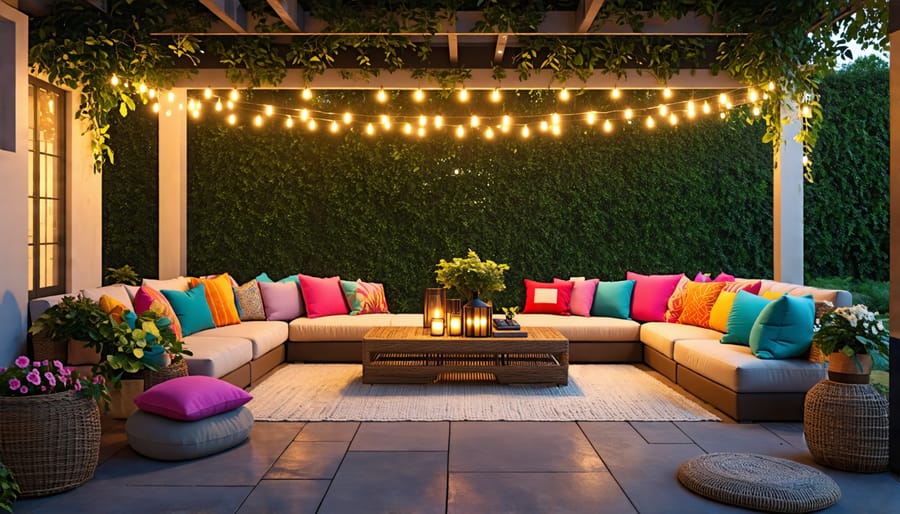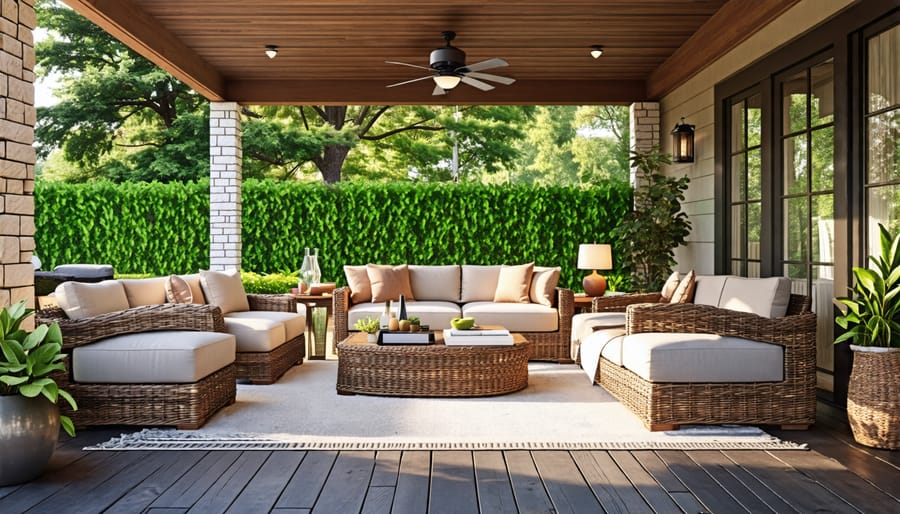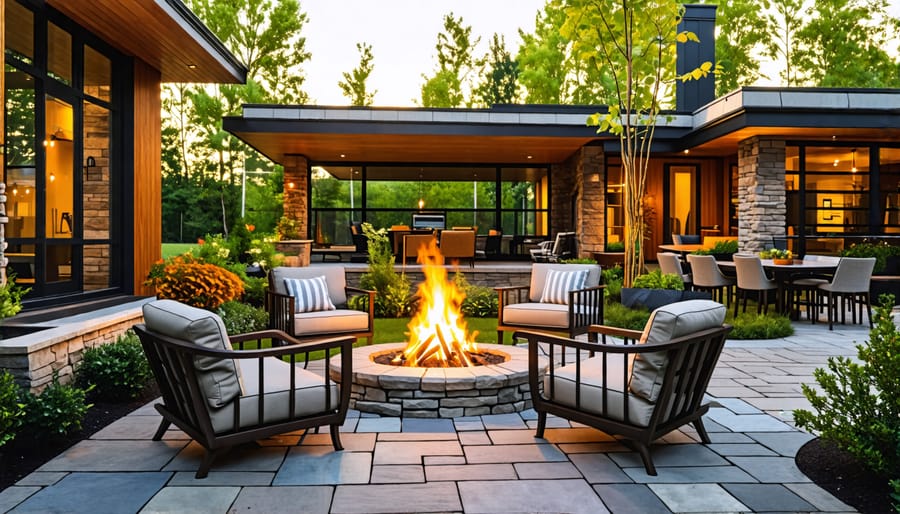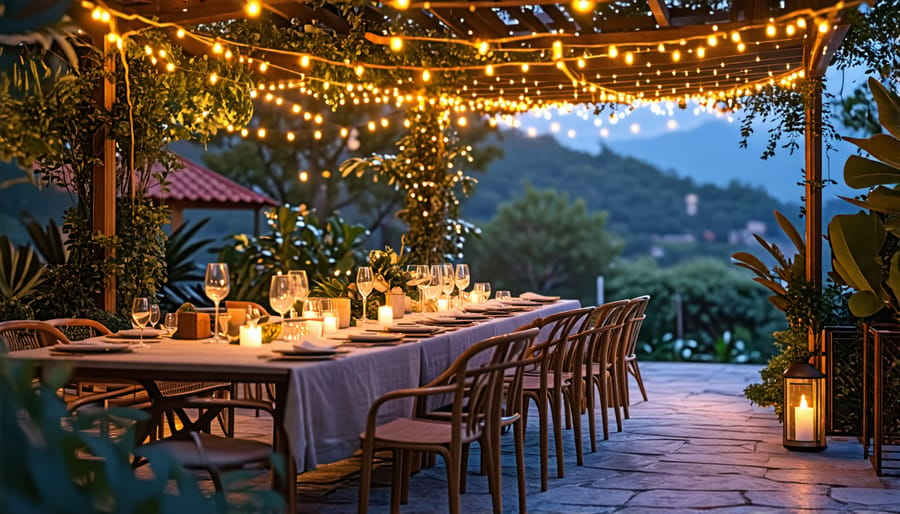
12 Dreamy Outdoor Living Spaces You Can Create This Weekend
Envision your ideal outdoor oasis by considering how you want to use the space, whether for relaxing, entertaining, or both. Establish distinct zones for different activities, such as dining, lounging, and recreation, to maximize functionality and flow. Incorporate effortless outdoor decor elements that reflect your personal style, from comfortable seating and plush cushions to striking accent pieces and mood-setting lighting. Seamlessly blend your outdoor living area with the surrounding landscape by using native plants, natural materials, and colors that complement your home’s exterior.
Plan Your Perfect Outdoor Oasis

Determine Your Outdoor Living Needs
When planning your outdoor living space, it’s crucial to consider your specific needs and goals. Start by asking yourself a few key questions: How do you envision using the area? Will it primarily be for relaxing, entertaining, dining, or a combination of activities? How many people do you need to accommodate?
Next, evaluate the size and layout of your outdoor area. Consider the amount of space you have to work with and any existing features or constraints, such as trees, slopes, or neighboring properties. This will help you determine the feasible scope of your project.
Based on your intended use and available space, identify the essential functional zones to include. For example, if you love hosting barbecues, a dedicated grilling area with ample counter space and seating might be a priority. If relaxation is your main goal, a cozy lounge area with comfortable furniture and shade could be the centerpiece.
Don’t forget to consider practical factors like privacy, sun exposure, and weather protection. Strategically placed screens, pergolas, or plantings can create a sense of seclusion and shelter. Lastly, think about how your outdoor space will connect with your indoor living areas. Ensuring a smooth flow and cohesive design will make your outdoor room feel like a natural extension of your home.
Design for Flow and Function
When designing your outdoor living space, the key principles are traffic flow, designated zones, and balance. Thoughtful layout is essential for maximizing functionality and enjoyment.
Consider the natural traffic patterns and how people will move through the space. Create clear pathways using materials like pavers, gravel, or decking. Avoid dead ends or awkward bottlenecks that disrupt flow.
Establish distinct zones for different activities, such as dining, lounging, cooking, and playing. Use furniture placement, area rugs, or even different elevations to define these spaces visually. But maintain openness and avoid barriers that chop up the space excessively.
Aim for a balanced layout that is not too crowded or sparse. Incorporate a mix of larger anchor pieces and smaller flexible furnishings. Leave ample circulation space around furniture groupings.
Common layout mistakes include pushing all the furniture to the edges, which creates a vast unusable central void. Clustering everything too tightly also impedes traffic and makes a space feel cramped. Spreading things too far apart lacks intimacy and coherence.
The ideal layout has a natural flow with comfortable spacing between elements. Distinct zones allow for different concurrent activities. And the overall composition balances visual weight and utility, creating an inviting, functional outdoor room.
Create Cozy Conversation Areas
Selecting the Right Outdoor Furniture
When selecting outdoor furniture, prioritize pieces that balance comfort, durability, and style to create an inviting alfresco oasis. Opt for weather-resistant materials such as powder-coated aluminum, teak, or all-weather wicker, ensuring longevity through sun, rain, and seasonal changes. Consider the care and maintenance required for each material, as well as storage options during inclement weather. Plush cushions in fade-resistant fabrics add both comfort and visual appeal, while umbrellas provide respite from the sun’s rays. Choosing outdoor furniture that complements your home’s architectural style creates a cohesive flow between indoor and outdoor spaces. For a modern aesthetic, sleek lines and neutral tones work well, while more traditional homes may benefit from classic wrought iron or wicker designs in warm, earthy hues. Mix and match pieces to create functional zones for dining, lounging, and entertaining, keeping in mind the scale of your space and the number of guests you typically host. With thoughtful selection and arrangement, your outdoor furniture will beckon family and friends to relax and enjoy the alfresco ambiance.
Arranging Furniture for Comfort and Conversation
When arranging outdoor furniture, the goal is to create inviting spaces that encourage relaxation and conversation. Start by considering the size and layout of your outdoor area. For smaller spaces, opt for a cozy seating arrangement with chairs facing each other to facilitate intimate discussions. In larger areas, you can create multiple conversation zones by grouping furniture into distinct clusters.
To promote a sense of openness and flow, leave ample space between furniture pieces and arrange them in a way that allows for easy movement. Position seating to take advantage of natural focal points, such as a beautiful view or a fireplace. If your outdoor space lacks a built-in focal point, create one by arranging furniture around a central element like a coffee table or an outdoor rug.
When it comes to seating, comfort is key. Choose furniture with plush cushions and ample back support to encourage lingering and leisurely chats. For a more versatile setup, consider incorporating modular furniture or pieces that can be easily rearranged to accommodate different group sizes and activities.
Don’t forget to include side tables or ottomans to provide convenient spots for setting down drinks, snacks, or books. By thoughtfully arranging your outdoor furniture, you can create an inviting atmosphere that encourages people to gather, relax, and engage in memorable conversations.

Design an Outdoor Dining Destination

Alfresco Dining Furniture and Lighting
When it comes to alfresco dining, the right furniture and lighting can make all the difference. For tables, consider durable materials like teak, eucalyptus, or powder-coated aluminum that can withstand the elements. Look for features like expandable leaves or built-in umbrella holes for added versatility. Pair your table with comfortable chairs featuring weather-resistant cushions in fade-proof fabrics. Opt for styles with stackable or folding designs for easy off-season storage.
To create a warm and inviting ambiance, layer your lighting options. String lights overhead provide a magical glow, while lanterns or battery-operated candles on the table add a touch of intimacy. For a more permanent solution, consider installing recessed lighting or wall-mounted sconces around your dining area.
Remember to protect your investment by covering or storing furniture when not in use, and regularly cleaning cushions and frames to prevent mildew and extend their lifespan. With these tips in mind, you’ll be well on your way to creating an outdoor dining oasis that you and your guests will love.
Outdoor Kitchen Considerations
Elevate your outdoor cooking experience by creating a fully-equipped outdoor kitchen. Consider the layout carefully, ensuring it flows well with your other outdoor living areas. Incorporate ample counter space for food prep and serving, as well as storage for utensils and dinnerware. Invest in durable, weather-resistant materials like stainless steel, stone, or concrete for countertops and cabinetry.
When selecting appliances, think about your cooking style and entertaining needs. A high-quality built-in grill is a must, but you might also want to include a pizza oven, smoker, or cooktop. Don’t forget the convenience of outdoor-rated refrigeration for keeping ingredients and beverages chilled.
Depending on your budget and space, you could add a sink with hot and cold water for easy clean-up, or even a dishwasher. Lighting is crucial for evening entertaining, so incorporate task lighting over the cooking and prep areas, as well as ambient lighting for a cozy atmosphere.
While costs can vary significantly based on size, materials, and appliances, expect to invest several thousand dollars for a well-appointed outdoor kitchen. However, the enhanced functionality and enjoyment it brings to your outdoor living space make it a worthwhile splurge for many homeowners.
Add Ambiance with Accessories
Accessories are the icing on the cake when it comes to creating an inviting and personalized outdoor living space. Just like with indoor decor, carefully selected accents can transform a basic patio or deck into a true extension of your home. Throw pillows in weather-resistant fabrics add pops of color and comfort to seating areas, encouraging guests to kick back and relax. An outdoor rug helps define the space and adds texture underfoot, creating a cozy vibe.
Lighting is another key accessory for setting the mood. String lights overhead create a magical ambiance for evening gatherings, while lanterns placed around the perimeter provide a warm, inviting glow. For a artistic touch, consider hanging weather-safe artwork or sculptures on exterior walls or nestled among plantings.
Other fun accents to play with include colorful planters, unique serving pieces, and even outdoor curtains to add softness and privacy. The key is choosing accessories that not only withstand the elements but also speak to your personal style. Don’t be afraid to mix and match patterns, colors and textures to create a one-of-a-kind look.
As you select accessories, also consider their function. Exterior clocks, thermometers and barometers are both decorative and practical. Likewise, items like citronella candles and throw blankets keep bugs at bay and ward off evening chills, helping you and your guests enjoy your outdoor oasis even longer.
With some creativity and carefully curated accessories, you can elevate your outdoor space from ordinary to extraordinary. Have fun infusing your personality into the area to make it a true oasis you’ll love spending time in.
Integrate Natural Elements
Integrating natural elements into your outdoor living space is a fantastic way to create a harmonious connection with the surrounding environment. One of the easiest and most impactful methods is incorporating plants. Consider placing potted plants strategically around your seating areas, on tables, or hanging from pergolas. Choose a mix of colors, textures, and sizes to add visual interest and depth. For a low-maintenance option, opt for native plants that thrive in your local climate.
Water features, such as fountains or small ponds, can add a soothing ambiance to your outdoor oasis. The gentle sound of trickling water creates a calming atmosphere and can help mask unwanted noise from neighboring areas. When selecting a water feature, consider the size of your space and the overall design aesthetic you want to achieve.
Fire elements, like fire pits or outdoor fireplaces, not only provide warmth on cool evenings but also serve as captivating focal points. They encourage gathering and socializing, making them perfect for entertaining. When incorporating fire elements, prioritize safety by ensuring proper placement away from flammable materials and providing ample seating space around them.
Using natural materials throughout your outdoor living area further enhances the connection with nature. Opt for wood, stone, or wicker furniture pieces that complement your home’s exterior. These materials age gracefully and develop a charming patina over time. You can also transform your home‘s interior by bringing in natural elements like organic fabrics, live-edge wood accents, and indoor plants to create a cohesive flow between your indoor and outdoor spaces.
Remember, the key to successfully integrating natural elements is to strike a balance. Avoid overcrowding your space and be mindful of the maintenance requirements for each element. With thoughtful placement and care, these natural touches will elevate your outdoor living area into a serene and inviting retreat that seamlessly blends with its surroundings.
Conclusion
In summary, creating an enviable outdoor living space is all about thoughtful planning, functional furnishings, and personal flair. By considering your space, lifestyle, and design preferences, you can craft an outdoor oasis that’s perfect for relaxation, entertainment, and enjoying nature’s beauty. Remember to prioritize comfort, durability, and style when selecting furniture and decor. Don’t forget the power of lighting, greenery, and eco-friendly DIY touches to elevate the ambiance. With these elements in place, your dream outdoor retreat is within reach. So why not start this weekend? Grab your tools, unleash your creativity, and transform your outdoor space into a true extension of your home. Happy designing!
